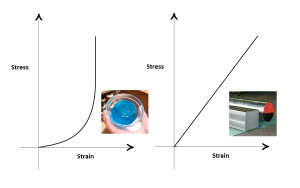Hyperelasticity has long been a fundamental framework for modeling the mechanical behavior of nonlinear materials. However, it has limitations in capturing all observed material responses. Below are key points summarizing the discussion:
- Hyperelasticity: A well-established theory used to describe nonlinear material behavior.
- Explicit Elasticity: Characterized by a one-to-one stress-strain relationship (each strain corresponds to a unique stress and vice versa).
- Limitations: Some materials in nature exhibit a many-to-one stress-strain response, which hyperelasticity cannot capture.
- Implicit Elasticity: A broader framework that accommodates materials with non-unique stress-strain responses, addressing the shortcomings of hyperelastic models.
Characterization of smart stimuli-responsive hydrogels.

Stimuli-responsive hydrogels are used in many fields of science as materials in lab on a chip devices because of their ability to serve as both sensors and actuators. Mechanical characterization of these materials is an ongoing field of research because of the multitude of physical phenomena that are present when these materials are in use. We seek to characterize stimuli-responsive hydrogels using principles from solid mechanic.
Relevant Publications
- Benjamin, C. C., Lakes, R. S., & Crone, W. C. (2018). Measurement of the stiffening parameter for stimuli-responsive hydrogels. Acta Mechanica, 1-11.
Publications by Collaborators
- Freed, A. D. (2017). A note on stress/strain conjugate pairs: Explicit and implicit theories of thermoelasticity for anisotropic materials. International Journal of Engineering Science, 120, 155-171.
- Freed, A. D., & Rajagopal, K. R. (2016). A promising approach for modeling biological fibers. Acta Mechanica, 227(6), 1609-1619.
- Muliana, A., Rajagopal, K. R., & Wineman, A. S. (2013). A new class of quasi-linear models for describing the nonlinear viscoelastic response of materials. Acta Mechanica, 224(9), 2169-2183.
- Rajagopal, K. R. (2003). On implicit constitutive theories. Applications of Mathematics, 48(4), 279-319.
